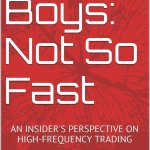
I’m trying to figure out where electronic and high frequency trading firms fit with respect to Alignment, and how I feel about that.
Alignment
I mean “Alignment” the way a Dungeons and Dragons (D&D) player means it (full disclosure: I’m a Lawful Good Half-Elf Bard in real life. I mean, in the game. I mean, outside of my writing. Whatever, you know what I mean.) All D&D characters are either Good, Neutral, or Evil, and act either Lawfully, Chaotically (law-breaking), or Neutrally (in between).
So, on our quest to understand electronic trading, it is helpful to know which alignments electronic traders fall under, including high frequency traders (HFTs)?
But First: A Definition
Instead of making human judgments about when and how much to trade stocks (or bonds, or currencies, or commodities or derivatives) electronic traders program computers to make those decisions, usually based on some set of conditions that indicate a momentarily profitable opportunity. Electronic, or ‘algorithmic’ trading, is about 25 to 30 years old. High frequency trading is a subset of electronic trading, except done at a humanly unimaginable pace – like 1,000 to 10,000 buy or sell orders per second. High frequency trading is about 10 to 15 years old. In recent years electronic trading accounts for between 50-75 percent of all stock market trading. Like SkyNet or Hal 9000, this naturally makes the humans nervous. But are they good or evil or neutral? [1]

Are HFTs Chaotic Evil?
If you read Michael Lewis’ 2014 book Flash Boys the most widely read story about the high frequency trading industry to date – you would develop the strong impression that these firms hew to chaotic evil on the D&D alignment compass.
In Lewis’ story, HFTs operate as predatory sharks attracting unwitting investors inside broker-sponsored ‘dark pools,’ all the better to extract trading profits through quick-strike trading against slow-footed prey. These evil creatures also use ‘spoofing’ subterfuge and aggressive ‘front running’ tactics. I expand on these tactics below.
‘Spoofing’ – in which electronic trading firms send large numbers of false orders to market exchanges, only to cancel them immediately, is a ploy (I admit I can’t explain in plain English exactly how this would work) to manipulate markets, and is clearly chaotic. It’s also illegal, and would lead to enforcement action against any firm doing this and getting caught.[2]
‘Front-running’ – in which an electronic trading firm uses prior knowledge about a customer order to buy or sell ahead of a customer for its own profit is also evil, as well as clearly illegal.[3]
And Flash Crashes
Many blame recent occurrences of “flash crashes” on algorithmic trading. Flash crashes are exactly the kind of mess that chaotic evil-doers would wish on markets.
Increasing the frequency or severity of flash crashes is the most likely way in which electronic trading causes chaotic evil effects. I don’t mean intentionally, but rather as an unintended consequence of numerous market players pursuing their own strategy. Something like: All market signals indicate to the algorithms the need to sell – all at the same time – which becomes a self-fulfilling downward spiral for prices. That type of unintended effect, however, predates the rise of HFTs. The 1987 Crash, for example, stemmed from the rise of ‘portfolio insurance’ that caused many institutions to suddenly need to sell securities, all at the same time, to limit losses. In the absence of real news, prices drop on such rush-for-the-exits stampedes.
On the issue of crashes and market glitches, there’s the not-too-infrequent case of human traders – not only computer traders – doing a bad job of ensuring orderly markets. This happened in August in a high-profile case of the floor trader on the NYSE who halved the value of publically traded KKR, a company whose markets he was responsible for trading, for about 15 minutes, for no apparent reason. The right standard for comparing human trader to computer trader is probably not “error-free,” but rather frequency and severity of mistakes and glitches like this. My point here is that human traders can probably screw up markets just as badly as programmed computers.
Or Lawful Good?
My friend Peter Kovac wrote a book last year – Flash Boys: Not So Fast, as a response to Michael Lewis’ book, in which he argues not only that Lewis got many details of the industry wrong, but perhaps the HFTs should be regarded instead as something like Lawful Good (my words, not Kovac’s.)
I’ll explore some of Kovac’s reasoning in follow-up posts, but for the moment I have in mind what I wish, and perhaps think to be true, regarding electronic traders.
Lawful Neutral
As a Dungeons and Dragons player (as well as a greedy capitalist,) I would hope for Lawful Neutral alignment among high-speed electronic traders. I mean, I don’t expect a trader to be saving the whales or reducing carbon emissions when he or she programs a computer algorithm to buy and sell securities at light speed. Their goals, as for-profit companies, are to make a profit. But I do expect them to always follow the law.
What Lawful Neutral means to me is that as long as they follow the rules – avoid conscious or even unintended evil-doing – then I’m ok with extraordinary profits accruing to electronic traders. That’s because I believe the profits of an algorithmic trading firm will mostly come at the expense of legacy Wall Street trading firms (the “old guard”) which are slower, or which operate at less efficient (meaning, wider) margins. I’ll write more about this next week as well.
A version of this post ran in the San Antonio Express News.
Please see related posts:
Book Review: Flash Boys by Michael Lewis
Book Review: Flash Boys Not So Fast by Peter Kovac
Book Review: Inside The Black Box, by Rishi Narang
[1] Assigning corporate alignments in D&D fashion is not necessarily new. Google’s previous corporate motto “Don’t Be Evil” is a seemingly simple standard, for example, from which to begin to evaluate high frequency trading. I’m not sure Google founders Brin and Page ever played D&D, but let’s just say it’s not unlikely that they know their way around a 20-sided die, right? Also, did anybody else notice Google dropped “Don’t Be Evil” as a corporate motto? Do you think it means what I think it means?
[2] My sense is that while this has happened in the past, it’s not normal market practice among electronic trading firms, any more than spamming is normal market practice among marketing companies. Sort of like: there are spammers, and there are marketers, but these are different types of firms with different business models
[3] Incidentally, front running as a business practice is probably as old as any stock brokerage business, it just happens that speedy trading could make it more easily perpetrated, and more easily hidden, at least for a time. Any firm shown to front-run as a business practice, however, would be fined and regulated out of the trading business.
Post read (854) times.










